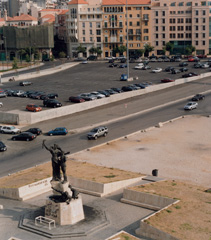Indeed, "I love you for ever Hiba" was "taken" on one of the photographs that gives read this inscription at the Statue of the Martyrs, Place des Martyrs in the heart of Beirut. This title will now serve as equity Lebanese love to travel in the summer of 2005, as the presence of which always resist the turbulence of the world, and where historically, before 1975, the pulse beat of the city at full speed, (as the square was the place trade ports and crossings of the peoples of the Mediterranean basin and beyond), the role of martyrs – following the war that lasted fifteen years – is now shaved, deserted, made a vast solitude of parking without a soul, insidiously bordered by the virgin megastore and uptown facelift with great capital of the trust Solidere.
If the work of Monique Deregibus remains committed to meet with cities – not just which of course – because it will always try to keep alive a form of violence in representation that would intimate equivalence the very act of photography. In this context, the title of the exhibition (and book) is a kind of impertinent challenge to thwart the tragic fate of the city to fully explain what light of love, through his heroic gesture, wins and is now able to haunt the area.
If the work of Monique Deregibus remains committed to meet with cities – not just which of course – because it will always try to keep alive a form of violence in representation that would intimate equivalence the very act of photography. In this context, the title of the exhibition (and book) is a kind of impertinent challenge to thwart the tragic fate of the city to fully explain what light of love, through his heroic gesture, wins and is now able to haunt the area.
Monique Deregibus
Photographe
Monique Deregibus is a photographer and professor at the Ecole Nationale Supérieure des Beaux – Arts in Lyon. “The Cyprus House, 2009-2013” is the third book produced in collaboration with Filigranes, Paris.
Each of the photographic series, inherited from a history of the conceptual landscape, is devoted to specific territories, sometimes near or far, always showing a strong interest for the unconscious reminiscences contained in the plan as well as for the notions of architecture and territory urban. These spaces, most of which are recorded in an editorial work, can be read as forming the abandoned scene of human tragedies.


